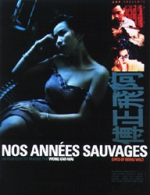Days of Being Wild (1991) [Festival]
The story and the plot are generally in the same flow. However, the plot has a bit more self-narrative of the characters and a bit more extra scenes of the story. The word "extra" I use is meaning the scenes irrelevant to the flow of story, but not the story itself. For instances, the two scenes of bird view's of the tropical rain forest in the beginning and ending of movie with Yuddy's self-narration, the scene of hospital in Hong Kong showing how Yuddy's foster mother received Yuddy in the past with her self-narration and the final scene of an unknown man preparing to go out. The hospital scene is neither the flashback of memories nor the scene describing the dialogues between characters. The extra scenes are to provide extra information to the audience which the Yuddy himself himself does not know either, like the reason behind why Yuddy's foster mother brings up Yuddy and keeps him so long until his age of 18 just because of the money. The extra scenes also signifies the theme of the movie, days of being wild, like the scenes of bird's view of tropical rain forest giving the impression of passionate and freedom of green.
The opening of the narrative
The film opens with the protagonist, Yuddy sauntering up to the South China Athletic Association store where So Lai-Chun works, opening a bottle of coke, guessing So's name correctly and telling her that tonight she'll see him in her dreams. Several scenes in the beginning are within the time and space of South China Athletic. The opening sheds the flavour of green romance, casts a seductive shade to the movie and reflects Yuddy's trait of indulgence. Such exposition raises audience's expectations to see the effect of and the development which made up of such indulgence and romance. It also provides the audience the information of the trait of protagonists, like Yuddy's indulgence, passionate and love of freedom and So Lai-chun's reticence, love of stable affairs and longing of home. The intermediate scene of a bird's view of tropical rain forest symbolizes the theme of the movie, the wildness of green and the indulgence of Yuddy and also echos what Yuddy says in the movie, a bird with no legs.
The Pattern of the Narrative
Dialogues mentioning about the bird with no legs or signifying "flying" repeat in several ways so as to remind and emphasize the audience the theme of the movie. The first time is Yuddy's narration of his own thinking. The second is time is Yuddy being scolded by his foster mother who ask him to fly away. The third time is inside the train in Philippines, street cop scolded Yuddy about his thinking of flying birds without legs. The fourth time is the bird's view of tropical rain forest with Yuddy's self-narration. The increased temporal frequency of the dialogues mentioning about the flying birds and the repeated scenes of the bird's view of tropical rain forest underlines the importance of the main idea of the movie, the indulgence of green and days of being wild.
The repeated dialogues mentioning the same ideas also provide a change in knowledge of the protagonist. Firstly, Yuddy self-narrate his own thinking about the flying bird without legs. After the arguing with his foster mother, the street cop and experiencing the death of himself, Yuddy changes his mind. His moment of death provides a turning point of himself, and that he finally understands and realizes the flying bird is already dead in the very beginning. Yuddy learns something in the course of action (meditation before his death).
The Closure
The closure accounts for the story of other characters, like So Lai-chun continue her ticketing job in South China Athletic Association, street cop continue his sailing job without knowing So Lai-chun's phone calls, Mimi goes ahead of her dreams in Philippines finding Yuddy endlessly, an unknown man is preparing to leave his house leaving it blank to the audience and raising the audience's curiosity and expectation of a second episode of the movie. The closure remains relatively open. The plot leaves the audience uncertain about the final consequences of the story events. The form encourages the audience to imagine what might happen next or to reflect on other ways in which expectations might have been fulfilled.
 Buy | Info |
 Buy | Info |
 Buy | Info |
 Buy | Info |
 Buy | Info |
 Buy | Info |
 Buy | Info |
 Buy | Info |
 Buy | Info |
 Buy | Info |
 Buy | Info |
 Buy | Info |
 Buy | Info |
 Buy | Info |
 Buy | Info |
 Buy | Info |




